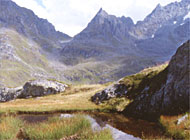Communities vie to become home of new national park

Three regions have emerged as favourites to become Switzerland's new national park, following the launch of a campaign to establish a second park. The winner stands to gain initial funding of more than SFr1 million ($585,000).
Switzerland’s main nature protection body, Pro Natura, says the three regions appear to meet the strict criteria required to become a national park, and that all have the backing of the local populations.
Ninety communities had signalled that they were interested in becoming the location of the new park.
The three regions selected are Val de Bagnes in canton Valais, the Rheinwaldhorn/Adula region stretching into Graubünden and Ticino, and the Vallemaggia in Ticino.
The 200 kilometre-high alpine region in the Val de Bagnes is dominated by the 4,000 metre-high Massiv des Grand Combin and several glaciers. The Vallemaggia is marked by narrow valleys and high cliffs.
Fabrizio Keller is head of the third leading project, the Adula/Rheinwaldhorn area which straddles Ticino and Graubünden.
“The Adula/Rheinwaldhorn area is a symbol for Switzerland because it includes the source of the Rhine River and it lies on the south side of the Alps. It is also a very large area, ideal for a national park. There are also three cultures and languages represented in the area: Romansch, German and Italian.
“Also, two cantons are involved. These aspects are very Swiss and we think that it is a very good proposal,” Keller told swissinfo.
The regions are by no means assured of gaining the park. To qualify, each must be at least 100 square kilometres in size, with a minimum of 25 square kilometres lying below the tree line.
A spokeswoman for Pro Natura, Silva Semadeni, said the regions will also have to satisfy a series of exacting criteria. “Not only must the area meet strict standards of nature protection, but it will also have to demonstrate that it can reconcile the conflicting demands of nature protection, hunting and agriculture.”
The regions are also required to secure the agreement of the local population. Unlike many countries, where opposition to nature conservation comes from industry, Switzerland’s dense population means that communities are often most opposed to conservation projects because of concerns that they will impinge on their lives.
Switzerland established Europe’s first national park in Graubünden in 1914. However, unlike its neighbours, it has not created any others, and is currently embroiled in a row with local residents over plans to extend the existing park.
In its most recent Environmental Performance Review, the Organisation for Economic Cooperation and Development (OECD) criticised Switzerland for failing to implement sufficient measures to protect nature, landscapes and biodiversity. The head of Pro Natura, Otto Sieber, says the creation of a second national park could go a long way to improve its record.
“Biodiversity is greater in Switzerland than some of its neighbours because we have the climate, flora and fauna of the northern and southern Europe. We have influences from the east and the Balkans, as well as from the Mediterranean Alps and the west. It is a crossroads where the different influences come together,” Sieber told swissinfo.
swissinfo with agencies

In compliance with the JTI standards
More: SWI swissinfo.ch certified by the Journalism Trust Initiative
You can find an overview of ongoing debates with our journalists here. Please join us!
If you want to start a conversation about a topic raised in this article or want to report factual errors, email us at english@swissinfo.ch.